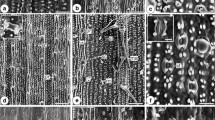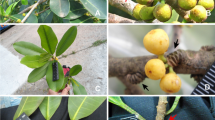Abstract
Morphoanatomical features can provide useful information for plant taxonomy. In Oxalis sect. Polymorphae (Oxalidaceae) there are currently 12 accepted species, mostly from the Brazilian Atlantic Forest, but the historical recognition of some infraspecific taxa may have resulted in underscored species richness. Integrated analyses of additional types of data are critical to evaluate if some taxa would be better recognized at species level. To evaluate this, we carried out leaf morphoanatomical analysis of O. neuwiedii subsp. neuwiedii and O. neuwiedii subsp. pardoensis and a phylogenetic analysis of nrITS sequences. Both leaf morphoanatomy and phylogenetics lend support to recognize O. neuwiedii subsp. pardoensis at species level. Leaflet venation pattern, epidermal cell outline, hair-covering, vascular conformation of the pulvina, and tissue organization in the midvein were the main morphoanatomical diagnostic features for the recognition of two species instead of a single one. A new rank and the second-step lectotypification are proposed for this taxon, raising to 13 accepted species in O. sect. Polymorphae.










Similar content being viewed by others
Availability of data and material
DNA sequences will become available at GenBank.
Code availability
Not applicable.
References
Athayde AE, Richetti E, Wolff J, Lusa MG, Biavatti MW (2019) “Arnicas” from Brazil: comparative analysis among ten species. Revista Brasil Farmacogn 29:401–424. https://doi.org/10.1016/j.bjp.2019.02.006
Beentje H (2016) The kew plant glossary: an illustrated dictionary of plant terms, 2nd edn. Royal Botanic Gardens, Kew
Caires CS, Gomes-Bezerra KM, Proença CEB (2012) Novos sinônimos e uma nova combinação em Pusillanthus (Loranthaceae). Acta Bot Brasil 26:668–674. https://doi.org/10.1590/S0102-33062012000300016
Carvalho R, Cristina L, Pellissari O, Pace MR, Scremin-Dias E, Arruda RO, Farinaccio MA (2017) Leaf morphoanatomy of Araujia and Morrenia (Asclepiadoideae, Apocynaceae): phylogenetic implications and species key. Bot J Linn Soc 20:1–14. https://doi.org/10.1093/botlinnean/bow004
Chitchak N, Traiperm P, Staples G, Rattanakrajang P, Sumanon P (2018) Species delimitation of some Argyreia (Convolvulaceae) using phenetic analyses: insights from leaf anatomical data reveal a new species. NRC Res Press 17:1–17. https://doi.org/10.1139/cjb-2017-0108
Devecchi MF, Pirani JR, Melo-de-Pinna GFA (2015) Comparative leaf anatomy and morphology of some Brazilian species of Crotalaria L. (Leguminosae: Papilionoideae: Crotalarieae). Acta Bot Brasil 28:583–593. https://doi.org/10.1590/0102-33062014abb3517
Dickison WC (2000) Integrative plant anatomy. Academic Press, San Diego
Doyle JJ, Doyle JL (1987) Isolation of DNA from fresh plant tissue. Focus 12:13–15
Eiten G (1963) Taxonomy and Regional Variation of Oxalis Section Corniculatae. I. Introduction, Keys and Synopsis of the Species. Amer Midl Naturalist 69:257–309
Ellis B, Daly DC, Hickey LJ, Johnson KR, Mitchell JD, Wilf P, Wing SL (2009) Manual of leaf architecture. Cornell University Press, Ithaca
Evert RF (2006) Esau’s plant anatomy: Meristems, cells, and tissues of the plant body: their structure, function, and development. Wiley, Hoboken
Fiaschi P (2012) Two new species of Oxalis sect. Polymorphae (Oxalidaceae) from the Brazilian Atlantic Forest. Kew Bull 67:33–38. https://doi.org/10.1007/s12225-012-9330-3
Fiaschi P (2014) Three new species and a revised key to species of Oxalis section Polymorphae (Oxalidaceae). Brittonia 66:134–150. https://doi.org/10.1007/s12228-013-9315-z
Fiaschi P, Conceição AA (2005) Oxalidaceae. In: Wanderley MGL, Shepherd GL, Melhem TS, Giulietti AM (eds) Flora Fanerogâmica do Estado de São Paulo, vol 4. FAPESP and RiMa, São Paulo, pp 301–315
Fiaschi P, Costa-Lima JL, Abreu MC, Costa TS (2020) Oxalis in Flora do Brasil 2020. Available at: http://floradobrasil.jbrj.gov.br/reflora/floradobrasil/FB12478. Accessed 17 Mar 2021
Filartiga AL, Bassinello V, Filippi GM, Bombo AB, Appezzato-da-Glória B (2016) Secretory duct distribution and leaf venation patterns of Aldama species (Asteraceae) and their application in taxonomy. Botany 94:1161–1170. https://doi.org/10.1139/cjb-2016-0172
Gomes SMAA, Silva EAM, Lombardi JA, Azevedo AA, Vale FHA (2005) Anatomia foliar como subsídio à taxonomia de Hippocrateoideae (Celastraceae) no Sudeste do Brasil. Acta Bot Brasil 19:945–961. https://doi.org/10.1590/S0102-33062005000400029
Gomes SM, Somavilla NSDN, Gomes-Bezerra KM, Miranda SC, Carvalho OS, Graciano-Ribeiro D (2009) Anatomia foliar de espécies de Myrtaceae: contribuições à taxonomia e filogenia. Acta Bot Brasil 23:224–238. https://doi.org/10.1590/S0102-33062009000100024
Gouy M, Guindon S, Gascuel O (2010) Sea View version 4: a multiplatform graphical user interface for sequence alignment and phylogenetic tree building. Molec Biol Evol 27:221–224. https://doi.org/10.1093/molbev/msp259
Grohar MC, Rosenfeldt S, Morales M (2018) Venation patterns in Mimosa subseries Dolentes and Brevipedes (Leguminosae) and their taxonomical inferences. Syst Bot 43:532–543. https://doi.org/10.1600/036364418X697256
Guesdon IR, Amorim AM, Meira RMSA (2018) The hydrochorous Amazonian genus Glandonia (Malpighiaceae): new records, morphoanatomy updates and taxonomic contributions. Phytotaxa 345:13–25. https://doi.org/10.11646/phytotaxa.345.1.2
Hickey L (1973) Classification of the architecture of dicotyledonous leaves. Amer J Bot 60:17–33
Hickey LJ, Taylor DW (1991) The leaf architecture of Ticodendron and the application of foliar characters in discerning its relationships. Ann Missouri Bot Gard 78:105–130. https://doi.org/10.2307/2399596
Johansen D (1940) Plant microtechnique. McGraw-Hill Book Co, New York
Jooste M, Dreyer LL, Oberlander KC (2016) The phylogenetic significance of leaf anatomical traits of southern African Oxalis. BMC Evol Biol 16:225. https://doi.org/10.1186/s12862-016-0792-z
Koch K, Bhushan B, Barthlott W (2009) Multifunctional surface structures of plants: an inspiration for biomimetics. Progr Mater Sci 54:137–178. https://doi.org/10.1016/j.pmatsci.2008.07.003
Kocsis M, Daro J, Borhidi A (2004) Comparative leaf anatomy and morphology of some neotropical Rondeletia (Rubiaceae) species. Pl Syst Evol 248:205–218. https://doi.org/10.1590/S0102-33062011000100021
Lima MPS, Soares A, Sousa JLR, Carvalho MS, Porto JMP, Braga FT (2019) Leaf architecture of Rubiaceae Juss. from caatinga vegetation in Brazil. Biota Neotrop 19:1–7. https://doi.org/10.1590/1676-0611-BN-2017-0473
Lopes-Mattos KLB, Otuki SAP, Azevedo AA, Pereira ZV, Meira RMSA (2015) Colleters in 10 species belonging to three tribes of Rubiaceae: morphoanatomical diversity and potential as useful characters for taxonomy. Botany 93:1–10. https://doi.org/10.1139/cjb-2014-0212
Lourteig A (1994) Oxalis L. subgénero Thamnoxys (Endl.) Reiche emend. Lourt. Bradea 7:s1–199
Lourteig A (2000) Oxalis L. Subgéneros Monoxalis (Small) Lourt., Oxalis y Trifidus Lourt. Bradea 7:201–629
Mendes TP, Simon MF, Alonso AA, Silva MJ (2021) Mimosa brevicalyx (Leguminosae-Caesalpinioideae): a new species based on molecular, anatomical, and morphological data. Pl Syst Evol 307:32. https://doi.org/10.1007/s00606-021-01745-4
Metcalfe CR, Chalk L (1957) Anatomy of the dicotyledons. Clarendon Press, Oxford
Mitchell JD, Daly DC (2015) A revision of Spondias L. (Anacardiaceae) in the Neotropics. PhytoKeys 55:1–92. https://doi.org/10.3897/phytokeys.55.8489
Oliveira MIU, Funch LS, Santos FAR, Landrum LR (2011) Aplicação de caracteres morfoanatômicos foliares na taxonomia de Campomanesia Ruiz & Pavón (Myrtaceae). Acta Bot Brasil 25:455–465. https://doi.org/10.1590/S0102-33062011000200021
Oliveira EF, Bezerra DG, Santos ML, Rezende MH, Paula JAM (2017) Leaf morphology and venation of Psidium species from the Brazilian savanna. Brazil J Pharmacogn 27:407–413. https://doi.org/10.1016/j.bjp.2017.03.005
Oliveira MIU, Rebouças DA, Leite KRB, Oliveira RP, Funch LS (2018) Can leaf morphology and anatomy contribute to species delimitation? A case in the Campomanesia xanthocarpa complex (Myrtaceae). Flora 249:111–123. https://doi.org/10.1016/j.flora.2018.10.004
Paiva EAS, Pinho SZ, Oliveira DMT (2011) Large Plants samples: How to process for GMA embedding? In: Chiarini-Garcia H, Melo RCN (eds) Light microscopy: methods and protocols. Springer/Humana, New York, pp 37–49
Pereira LBS, Costa-Silva R, Felix LP, Agra MF (2018) Leaf morphoanatomy of “mororó” (Bauhinia and Schnella, Fabaceae). Brazil J Pharmacogn 28:383–392. https://doi.org/10.1016/j.bjp.2018.04.012
Pirolla-Souza A, Arruda RCO, Pace MR, Farinaccio MA (2019) Leaf anatomical characters of Rhabdadenia (Rhabdadenieae, Apocynaceae), their taxonomic implications, and notes on the presence of articulated laticifers in the genus. Pl Syst Evol 305:797–810. https://doi.org/10.1007/s00606-019-01608-z
Posada D (2008) jModelTest: Phylogenetic model averaging. Molec Biol Evol 25:1253–1256. https://doi.org/10.1093/molbev/msn083
Radford AE, Dickson WC, Massey JR, Bell CR (1976) Vascular plant systematics. Harper & Row, New York
Rao TA, Das S (1979) Typology of foliar tracheoids in angiosperms. Proc Indian Acad Sci Pl Sci 88:331–345
Reis RE, Alvim MN (2013) Anatomia foliar comparada de três espécies do gênero Oxalis L. (Oxalidaceae). Periód Ci Núcleo Bioci Centro Univ Metodista Izabela Hendrix 3:59–72. https://doi.org/10.15601/2238-1945/PCNB.V3N6P59-72
Sakai WS (1973) Simple method for differential staining of paraffin embedded plant material using toluidine blue O. Stain Technol 48:247–249
Sant’Anna-Santos BF (2021) A new endemic and critically endangered species of Butia (Arecaceae) with comments on morpho-anatomical novelties in the genus. Pl Syst Evol 307:1–16. https://doi.org/10.1007/s00606-020-01729-w
Santos D, Arruda ECP, Buril MT (2020) Hidden in the rocks: A new species of Evolvulus L. (Convolvulaceae) revealed by anatomy. Brittonia 72:282–289. https://doi.org/10.1007/s12228-020-09615-y
Seixas DP, Fortuna-Perez AP, Rodrigues TM (2019) Leaf anatomical features of the Eriosema campestre Benth. (Leguminosae, Papilionoideae, Phaseoleae) complex and potential taxonomic implications. Flora 253:107–115. https://doi.org/10.1016/j.flora.2019.03.011
Shobe WR, Lersten NR (1967) A technique for clearing and staining gymnosperm leaves. Bot Gaz 128:150–152
Sun X-Q, Xue J-Y, Lei Z, Zhang Y-M, Li M-M, Zhou G-C, Hang Y (2018) Taxonomic and phylogenetic significance of leaf venation characteristics in Dioscorea plants. Arch Biol Sci 70:397–407. https://doi.org/10.2298/ABS170322058S
Swofford DL (2002) PAUP*: Phylogenetic Analysis Using Parsimony (and other methods). Version 4.0 Beta. Sinauer Associates, Sunderland
Thadeo M, Azevedo AA, Meira RMSA (2014) Foliar anatomy of neotropical Salicaceae: potentially useful characters for taxonomy. Pl Syst Evol 300:2073–2089. https://doi.org/10.1007/s00606-014-1037-5
Thiers B [continuously updated] Index Herbariorum: A global directory of public herbaria and associated staff. New York Botanical Garden’s Virtual Herbarium. Available at: http://sweetgum.nybg.org/ih/. Accessed 4 May 2020
Thompson JD, Gibson TJ, Plewniak F, Jeanmougin F, Hoggins DG (1997) The ClustalX windows interface: flexible strategies for multiple sequence alignment aided by quality analysis tools. Nucl Acids Res 24:4876–4882
Tucker SC (1964) The terminal idioblasts in magnoliaceous leaves. Amer J Bot 51:1051–1062
Vaio M, Nascimento J, Mendes S, Ibiapino A, Felix LP, Gardner A, Emshwiller E, Fiaschi P, Guerra M (2018) Multiple karyotype changes distinguish two closely related species of Oxalis (O. psoraleoides and O. rhombeo-ovata) and suggest an artificial grouping of section Polymorphae (Oxalidaceae). Bot J Linn Soc 188:269–280. https://doi.org/10.1093/botlinnean/boy054
Vargas WD, Sartori ALB, Dias ES (2015) Novelties in secretory structures and anatomy of Rhynchosia (Fabaceae). Anais Acad Brasil Ci 87:83–93. https://doi.org/10.1590/0001-3765201520130373
Vianna SA, Carmelo-Guerreiro SM, Noblick LR, Colombo CA (2017) Leaf anatomy of Acrocomia (Arecaceae): an additional contribution to the taxonomic resolution of a genus with great economic potential. Pl Syst Evol 303:233–248. https://doi.org/10.1007/s00606-016-1369-4
White TJ, Bruns T, Lee S, Taylor J (1990) Amplification and direct sequencing of fungal ribosomal RNA genes for phylogenetics. In: Innis MA (ed) PCR Protocols: A guide to methods and applications. Academic Press, San Diego, pp 315–322
Acknowledgments
We are grateful to Capes for the master’s fellowship to ER and the doctoral fellowship to TSC, the Brazilian National Council for Scientific and Technological Development (CNPq) for the Research Productivity grant to PF (PQ 306228/2016-5 and 310502/2019-5) and CMS (PQ 301772/2018-5), the Universal grant (420034/2018-8), and the PROTAX grant (441445/2020-9) to PF, FAPESC for the Supplementary grant FAPS PROTAX 22/2020 (2021TR389), and the Graduate Program in Biology of Fungi, Algae, and Plants from Federal University of Santa Catarina (UFSC) by financial and logistic support for this study. We are also in debt to the staff at the Electronic Microscopy Central Laboratory (LCME) and the Multi-user Laboratory in Biological Studies (LAMEB) from UFSC. Lara Lombardi and Jhonathan Radavelli are acknowledged for providing the SEM seed photograph.
Funding
Provided by Brazil’s CAPES (Master’s fellowship to ER) and National Council for Scientific and Technological Development (CNPq) (Grants 306228/2016–5, 310502/2019–1, 420034/2018–8 to PF and 301772/2018–5 to CMS).
Author information
Authors and Affiliations
Contributions
All authors contributed to the study conception and design. Material preparation, data collection and analysis were performed by E. Richetti, T.S. Costa, W.S. Cabral and P. Fiaschi. The first draft of the manuscript was written by E. Richetti, M.G. Lusa and P. Fiaschi, and all authors commented on previous versions of the manuscript. All authors read and approved the final manuscript.
Corresponding author
Ethics declarations
Conflict of interest
The authors declare that the manuscript does not present any kind of conflict of interest. The purpose and content of the work are original and not previously published.
Ethical approval
Not applicable.
Consent to participate
Not applicable.
Consent for publication
Not applicable.
Additional information
Handling editor: Thais N. C. Vasconcelos.
Publisher's Note
Springer Nature remains neutral with regard to jurisdictional claims in published maps and institutional affiliations.
Supplementary Information
Below is the link to the electronic supplementary material.
Information on Electronic Supplementary Material
Information on Electronic Supplementary Material
Online Resource 1. Sequence alignment of ITS region in FASTA format.
Rights and permissions
About this article
Cite this article
Richetti, E., Costa, T.S., Cabral, W.S. et al. Morphoanatomy and phylogenetics reveals a distinct species of Oxalis sect. Polymorphae (Oxalidaceae) from the Brazilian Atlantic forest. Plant Syst Evol 308, 16 (2022). https://doi.org/10.1007/s00606-022-01807-1
Received:
Accepted:
Published:
DOI: https://doi.org/10.1007/s00606-022-01807-1




